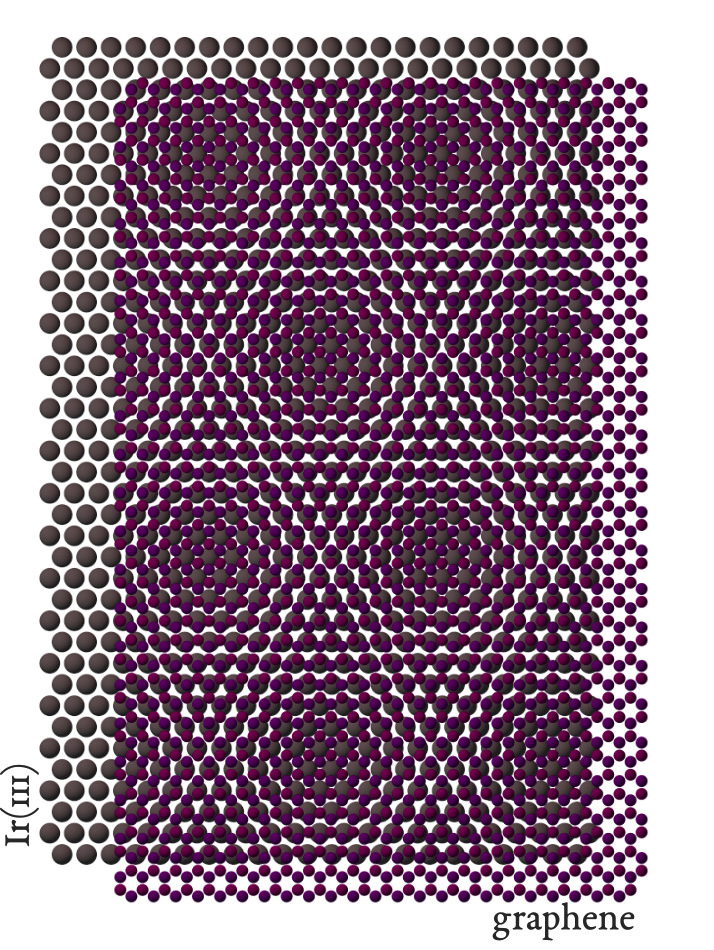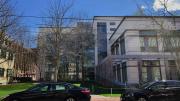Harvard will launch a Ph.D. program in quantum science and engineering, one of the first in the world, the University announced today. The program has been designed to train the next generation of leaders and innovators in a domain of physics already having transformative effects on electrical engineering and computer science, biology and chemistry—and poised to transform other fields, too, as researchers demonstrate increasing capability to harness and control quantum effects that defy explanations based on the principles of classical physics alone. Simultaneously, the University revealed that it plans a major renovation of 60 Oxford Street in order to house key portions of its ambitious quantum program. The transformation of that 94,000 gross-square-foot building, constructed in 2007, into a quantum-science and engineering hub is made possible by what the University described in a statement as “generous support from Stacey L. and David E. Goel ’93 and several other alumni.”
“Existing technologies,” said David Goel in the statement, “are reaching the limit of their capacity and cannot drive the innovation we need for the future, specifically in areas like semiconductors and the life sciences.” The co-founder and managing general partner of Matrix Capital Management Company, LP (a hedge fund based in Waltham, Massachusetts), called quantum science “an enabler, providing a multiplier effect…a catalyst that drives scientific revolutions and epoch-making paradigm shifts.” (The Goels previously made a $100-million gift to catalyze the University’s formation of a performing-arts venue in Allston that will include the relocated American Repertory Theater.)
The new doctoral degree builds on the 2018 launch of the Harvard Quantum Initiative, co-led by Silsbee professor of physics John Doyle, Tarr-Coyne professor of applied physics and of electrical engineering Evelyn Hu, and Leverett professor of physics Mikhail Lukin. Its program of study will draw on existing courses in quantum science—which encompasses physics at the scale of atoms and sub-atomic particles, or that is linked to the discrete energy states (quanta) associated with these objects—as well as courses in materials science, photonics, computer science, chemistry, and related fields. The aim is to provide, within a community of scholars and engineers, a foundational core curriculum that Hu said will dramatically reduce “the time to basic quantum proficiency for a community of students who will be the future innovators, researchers, and educators in quantum science and engineering.” The program is expected to admit its first cohort of Ph.D. candidates—about six students—in the fall of 2022; eventually, it will enroll 35 to 40 candidates. They will learn how to build quantum materials, including quantum bits (“qubits”) that perform switching functions analogous to those found in classical computers; how to stabilize and extend the life of quantum states; and how to design quantum information networks, among other skills.
The Ph.D. program
Quantum science and engineering is “a brand new field in many ways,” explained Hu, the faculty co-director, with Doyle, of the new doctoral program. Although Harvard and other institutions have invested in the study of quantum physics for decades, “This particular moment is timely”—and unusual, she said in an interview: even though “there’s still a tremendous amount of basic science to explore, and fundamental scientific questions and challenges,…companies are seizing the opportunity to go forward with commercial products.” Industry has recognized that quantum behaviors can be harnessed for practical use, even without an understanding of precisely why they exist. The entanglement of particles is one example, because it enables unbreakable quantum cryptography over quantum communication networks. Entangled photons and electrons are particles that have become linked, so that the state of one, when queried, is instantaneously “communicated” to the other, no matter where or how far away in the universe that entangled counterpart might be. Thus, if someone tried to steal data encoded using a quantum key by probing one of the particles, the other particle would immediately reveal the interference.
Currently, there simply aren’t enough graduates with expertise in quantum engineering to satisfy corporate demand. To fill that gap and advance basic science research in the field, the new doctoral program, said Hu, will provide an integrated approach that builds on quantum behaviors in “not just physics, not just chemistry, electrical engineering, computer science, applied math, and mechanical engineering, but a whole host of other disciplines. That is what motivates the Ph.D. program that we just launched.”
Christopher Stubbs, science division dean of the Faculty of Arts and Sciences and Moncher professor of physics and of astronomy, called Harvard’s investment in the field—at a time when University budgets are constrained, and hiring of new faculty has been limited in many other areas—“significant.” Beyond the renovation of 60 Oxford Street, several searches for new faculty members are already under way, in hopes of recruiting as many as 10 during the next decade to join an already active group of researchers and educators in the field. Several current faculty members have made notable contributions within the quantum domain in the past year alone, including assistant professor of physics Julia Mundy (the recipient of a $875,000 Packard Award to pursue her research in novel quantum materials during the next five years); professor of physics in residence Susanne Yelin (named a fellow of the Optical Society for “pioneering theoretical work in quantum optics”); and Kahn associate professor of chemistry and chemical biology and of physics Kang-Kuen Ni. (In 2018, Ni joined atoms of sodium and cesium, which normally don’t react with each other, into a single molecule that lasted for an instant. This year, her lab members were able to extend the life of that dipolar molecule to three and half seconds—more than enough time to make it useful in quantum applications.)
Numerous existing centers throughout the University will add depth in both quantum science and engineering in a variety of specific research areas. The Center for Integrated Quantum Materials, for example, is a National Science Foundation (NSF) Science and Technology Center for studying quantum materials with unconventional properties; the Center for Nanoscale Systems is focused on the science of small things, and their integration into larger systems; the Max Planck-Harvard Research Center for Quantum Optics is a collaboration between the Max Planck Institute of Quantum Optics and Harvard’s physics department that conducts research and education in a broad range of quantum sciences including metrology (measurement) and quantum-based information science. And the Center for Ultracold Atoms is a joint NSF Physics Frontier Center run together with MIT, with which Harvard has a longstanding collaboration in quantum-science investigations. John Doyle adds that he and his colleagues want to expand on this constellation of domain expertise by establishing a center for quantum theory in the new building, to which they can invite colleagues from around the world. At the practical, hands-on end of the spectrum, the building will also feature an instructional lab where undergraduate and graduate students will have an opportunity to work with quantum systems. Common areas in the building, he added, will provide natural opportunities “for theorists and experimentalists to connect.”
“An incredible foundation has been laid in quantum and we are now at an inflection point to accelerate that activity,” summed up Frank Doyle, dean of the Harvard Paulson School of Engineering and Applied Sciences and Armstrong professor of engineering and applied sciences (and no relation to John Doyle). Collaborations, he emphasized, will play an important role in that acceleration. To speed the translation of applied research into industrial products, Dean Doyle described a vision for “integrated partnerships where we invite partners from the private sector to be embedded on the campus to learn from the researchers in our labs, and where our faculty connect to the private sector and national labs” that have been affiliated with five quantum-information science research centers funded by the U.S. Department of Energy. The broad aim, he said, is to learn about “cutting-edge applications, as well as help translate…basic research into useful tools for society.”
Even though engineering using quantum behaviors can advance ahead of basic scientific understanding in some cases, as Evelyn Hu pointed out, predicting the behavior of quantum systems will require quantum computational abilities. A key applied-research area that will advance both the basic science and the engineering involves quantum simulation, a precursor to broadly useful quantum computation. Quantum simulators can be used to describe and potentially predict the behavior of quantum systems and materials. For example, nuclear magnetic resonance imaging (NMR) is now being used at Brigham and Women’s Hospital to identify small molecules in living subjects. To identify the molecules, NMR relies on a quantum probabilistic process. Interpreting the results with traditional computers would take days, but pairing a classical computer with a quantum simulator—a special-purpose computer which itself operates on quantum probabilistic principles—can identify the molecules in minutes.

When two sheets of a perfect crystalline material, just one atom thin, are placed atop one another, and then rotated or shifted, the resulting moiré patterns reveal repeatable, tunable electromagnetic landscapes that will make these materials useful in quantum devices.
Image courtesy of Wikimedia Commons.
In another example, quantum-materials engineers use one-atom-thick sheets of crystalline materials like graphene that have perfect symmetry (and no dangling bonds) to create new structures for controlling the behavior of electrons. When two sheets of this atomically identical material are placed atop one another, and one layer is then rotated slightly, a moiré pattern is created that contains areas of high and low energy—a kind of landscape of mountains and valleys with extraordinary tunable properties. Electrons trapped between the sheets congregate in the low-energy valleys, according to the bilayer material’s changing optical and electrical properties (which depend on the angle of rotation). But predicting exactly what those properties will be, so that they can be used for quantum-based electronics, is beyond the capability of classic computers, even those deploying artificial intelligence and advanced deep learning techniques.
Past successes in quantum-materials design, such as the extraordinary development of the quantum cascade laser by Wallace professor of applied physics Federico Capasso, were based on the behavior of single particles. Now investigators hope to exploit the vastly greater intricacy of polyatomic molecules, with three or more atoms, to make materials and devices with complex properties unexplainable using classical models of physics. The University’s deepening research and development capacity in this transformative field, in collaboration with other institutions, national laboratories, and industry, appears poised to provide both solid and compelling training for prospective scholars.
Candidates interested in the new Ph.D. in quantum science and engineering can learn more about the program philosophy, curriculum, and requirements here.
Read the University announcement here.









